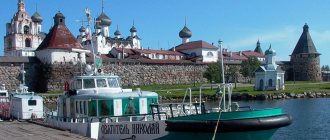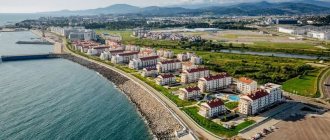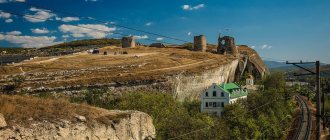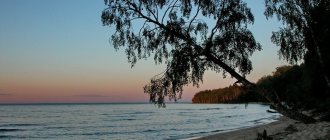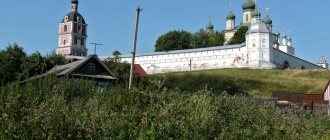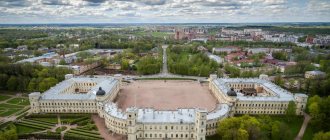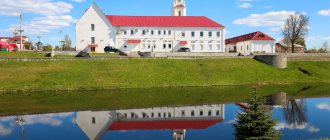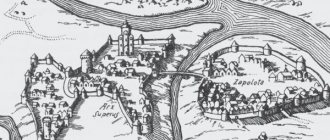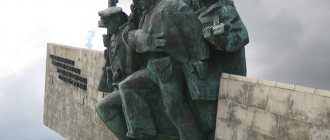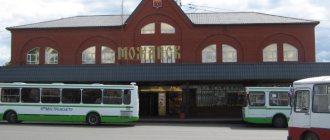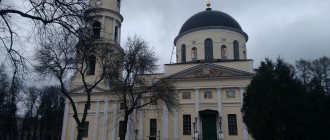Where are Solovki located?
The Solovetsky Islands are located in the southwestern part of the White Sea.
The islands block the entrance to Onega Bay. However, they are located 200 kilometers west of Arkhangelsk and in general did not represent any strategic interest either for the defense of the northern trade route or for the defense of the port of Arkhangelsk.
It is all the more surprising that the Solovetsky Monastery appeared on the islands, built as a full-fledged military fortress.
The place was not suitable for protection from the Swedes and the British.
Even as a center of Moscow’s influence on the local weakly subordinate Karelian tribes - too.
Kem or modern Rabocheostrovsk would be better suited for this. After all, mainland Karelia.
Why and why the treasury allocated money for the grandiose construction is unknown.
Northern monastery
The Solovetsky Monastery, the main attraction of the archipelago, is located on the western shore of the Big Solovetsky Island. It is located on a narrow strip between the eastern shore of Blagopoluchiya harbor and the Holy Lake. For a long time, the ancient monastery was an outpost on the northern borders of the Moscow state. Its first stone buildings were the Assumption Cathedral and the refectory. They appeared in 1557. The high fortress wall was built for quite a long time - in the period from 1584 to 1594.
Solovetsky Monastery
Huge granite boulders were used to build the walls of the citadel. Only those that did not need to be processed were used. The total length of the walls exceeds one kilometer. In plan, the fortress is a pentagon with an irregular shape. In 1617, the walls were protected on both sides by ditches, which were filled with water. Later, the northern ditch was drained and surrounded by a wooden palisade.
Harbor of Prosperity
When the ship approaches the island, the monastery gradually appears on the horizon like a magical castle. Tourists and pilgrims usually head straight to the fortress. Here you can purchase a detailed map of the island and a plan of the monastery buildings. Wandering through the labyrinths of the monastery is a fascinating activity. You can even get lost in the endless passages and halls. It is worth climbing the fortress walls to admire the magnificent panorama of the harbor and Lake Svyatoe.
Wandering through the labyrinths of the monastery is a fascinating activity
Hermitages are scattered throughout the island. The paths leading to them are laid through picturesque places and pass by numerous small lakes. The most beautiful path lies to Sekirnaya Mountain. At its top stands the Holy Ascension Monastery, founded in the 19th century. From the village to the monastery no more than 12 km. The temple is unique in that there is a lighthouse on its dome. The monks lit a fire every night from August 15 to November 15, showing the way to the fishermen. The lighthouse is still in operation today. Its height is 123 meters. There are 135 steps leading to the upper platform.
Residential buildings on the island
You should definitely visit Bolshoy Zayatsky Island, where St. Andrew’s Monastery is located. In 1691, a wooden chapel was moved here from the Big Solovetsky Island, which was built by the archers near the monastery during the so-called “Solovetsky Sitting”. This happened in the second half of the 17th century. In 1702, during the visit of Peter I, it was rebuilt into a church and consecrated in honor of the Apostle Andrew the First-Called. The temple is considered the oldest monument of northern wooden architecture.
How to get to the Solovetsky Islands?
Travel to Solovki follows standard options:
If the price of regular tours seems too high, you can go to the Solovetsky Islands on your own.
By train St. Petersburg-Murmansk or Moscow-Murmansk to Kem or Rabocheostrovsk stations.
There you can buy a ticket for regular ships.
The same ships also transport ordinary groups of tourists.
- Getting from Kem (Rabocheostrovsk) to Solovki - 2:00-2:30 hours
- The route of the ship from Belomorsk is 3:30-4:00 hours
Tickets for boats can be bought directly at the pier. But everything is based on the residual principle: tourists and locals - go ahead.
If there is a hitch on the way, there are normal hotels in Rabocheostrovsk and Kemi.
If you need it faster, then residents of St. Petersburg need to fly by plane to Arkhangelsk.
From there you can quickly get to Solovki by local airlines (flight about 50 minutes).
Or go to Petrozavodsk and from there you can also get to Solovki by plane.
There are no direct flights from St. Petersburg and Moscow. Although you can buy tickets for the flight St. Petersburg - Solovki, it still requires a transfer in Arkhangelsk.
It is almost impossible to get to Solovki directly by car.
But driving throughout Karelia, stopping by Petrozavodsk, Kondopoga and Medvezhyegorsk along the way, is very interesting.
From St. Petersburg everything is quite simple: the P-21 “Kola” highway (St. Petersburg-Murmansk) will lead almost to the White Sea coast.
Almost, because to get to Belomorsk, you have to turn past the village of Pushnoy (and another + 30 kilometers).
You need to turn off to Kem from Kola after the locks of the Putkinsky Reservoir.
Only 14 km of the Kem-Kalevala road will remain.
The condition of the roads is approximately the same. But from Kemi to the Solovetsky Islands it is much closer.
In any case, you will have to leave the car at the port and then get to Solovki on your own, by boat.
By car from Moscow there are two roads:
first to St. Petersburg with access to “Kola” or through Yaroslavl-Vologda along the northern shore of Lake Onega along the A-119 road.
In Mezhvezhyegorsk, A-119 merges with Kola. But there are almost no sights along the way.
There is only Vytegra, where it is interesting to see the ancient gateways from the time of Peter the Great (their remains). And the Submarine Museum.
, you can only get to Solovki
The ships do not operate during the off-season. When the ice freezes, people sometimes dare to take this route on snowmobiles.
And there is no point: life on the Solovetsky Islands comes to a standstill.
Outside residential buildings and the monastery, snow is not cleared. So it is impossible to see external sights.
Only the monastery, the Jung school and what remains of the legacy of the “GULAG archipelago”.
There is another very rare, but incredibly fantastic way:
Get to Solovki on your own, by boat.
Several such reports appear on the Internet every year.
These are big trips on cabin boats and even simple rubber boats! The impressions from such sea trips cannot be conveyed.
But you need to be very prepared.
Be able to lock, understand the navigation situation and unwritten rules on the river.
“Buy” rights in GIMS, buy a large motor yacht. Well, some people like it that way. But you will also have to take a suitcase of money with you.
And it’s not a fact that they will help.
Neither Ladoga nor the White Sea forgives mistakes.
And you could stand at the airlock wall for at least a day, if only the Abramovich was three times.
In Karelia, ordinary working people have their own concepts.
And not everything here can be bought for money.
But for experienced captains there is only one problem on the way - difficulties with refueling. .
Solovetsky secrets
On Solovki you can find evidence from various times. There are ancient churches and chapels, a biological station, a tar mill, a seaplane hangar and gun positions. Not far from the Holy Lake there are Gulag barracks, as well as the camp administration building. The island has many ancient buildings and simply beautiful natural places.
Solovki – a place of mysteries and secrets
Among the unusual attractions, it is worth noting the Botanical Garden. How is he unusual? The one located near the Arctic Circle! It was broken in the middle of the 19th century. The secret of the garden is its location - it is located in a hollow, which is surrounded on three sides by mountains. Almost half a thousand different plants have been adapted to life in the North! Even southern species have taken root here, not to mention apple trees, which bear fruit for more than 130 years. Some of the plants were planted by Gulag prisoners.
Northern birch trees have a curved trunk
Another interesting place is Cape Beluzhy. It is located ten kilometers from the village towards Mount Sekirnaya. The cape attracts tourists in the summer, when in the immediate vicinity of the coast you can see White Sea dolphins - beluga whales. Their length can exceed six meters!
Holy Lake
The Negotiation Stone is one of the historical monuments. Its history dates back to the period of the Crimean War. In 1854, the ships of the English fleet approached Bolshoi Solovetsky Island. The monks were presented with an ultimatum to surrender the fortress. The attackers responded to their refusal with a massive shelling of the monastery, which lasted two days. The monastery survived, and a memorial stone was erected at the site of the negotiations.
The most unusual attractions of the archipelago are the famous Solovetsky labyrinths, which appeared here in the 2nd-3rd millennium BC. Their age is 4-5 thousand years - they are older than the Egyptian pyramids. Even at the end of the 15th century, the church called them “demonic games” and “signs of evil spirits.” Approaching a labyrinth made of stones was considered a great sin.
Solovetsky labyrinth
One of the mysteries of the labyrinths is the fact that they appeared on the vast northern territory at the same time. Moreover, their distribution area covered almost the entire northern Europe. The second mystery is the huge number of labyrinths. More than 30 pieces are known on the Solovetsky Islands - on Anzer Island, on Bolshoi Solovetsky Island, but there are especially many of them on the Zayatsky Islands. In Europe the number is in the thousands.
It is amazing that after thousands of years, the unfortified structures remained almost undamaged. Not a single boulder collapsed or moved from its place - the spiral pattern seemed to be folded forever. And the third mystery is why were they built? One thing is clear - ancient people built them for something vital. Otherwise, it is difficult to explain such a wide distribution of labyrinths and the many stories associated with them.
Procession
Several interesting events are organized in the archipelago every year. So on July 13-14 the Solovetsky Fair takes place. Another spectacular event in July is the Solovetsky Regatta. In the same month they will organize a sea trip to Zayatsky Island. Traditionally, it is dedicated to the memory of military sailors who studied at the Solovetsky school of young boys. August 6-9 - Days of Remembrance for prisoners of the Solovetsky Special Purpose Camp. The art song festival “On the Solovetsky Islands” takes place on August 9-14.
How to get from Moscow to the Solovetsky Islands at any time of the year
Greetings, dear friends! Today we will talk about how to get to Solovki from Moscow.
The Solovetsky Islands are located near Arkhangelsk, in the White Sea. The archipelago stands at the entrance to Onega Bay.
You can get from Moscow to the Solovetsky Islands by various means of transport. Thanks to tourist interest, communications in this direction are quite well established.
Flora and fauna
The Solovetsky Islands, where excursions take place on the main island called “Bolshoy”, are distinguished by their pristine natural beauty. The main territory of Solovki is covered with forest, in which spruce and pine trees grow.
The coastal area is densely planted with algae, among which there are species of great industrial importance:
- kelp;
- fucus;
- ahnfeltsiya.
There are about 550 species of vascular plants in the archipelago, and almost 380 species of native plants.
Plant varieties differ in size and number:
| plant species | approximate number of species |
| sedge species | 44 |
| cereal | 39 |
| composite | 33 |
| rosaceous | 20 |
| norichnikovy | 16 |
| buttercup | 17 |
| clove | 15 |
| legume | 13 |
| orchidaceous | 12 |
| rushnik | 10 |
| willow | 12 |
| buckwheat | 11 |
Specific vascular plants that are characteristic of the northern taiga grow here:
- Elimus;
- cracker;
- crow with red fruits;
- northern aconite;
- Siberian prince;
- spear-shaped cacalia;
- lettuce;
- oak ragwort;
- garden tramp.
The fauna of Solovki is not very diverse. Animals here include many squirrels, foxes and hares. You can meet reindeer.
Sea inhabitants:
- harp seal and seal;
- sea hare and herring.
The White Sea is home to a very rare species of beluga whale. The length of such an individual is only 312 cm. In total, there are about 80 individuals here.
Lake inhabitants:
- roach and burbot;
- pike and perch;
- about 20 species of different mollusks.
Insects living on Solovki:
| type of insect | approximate quantity |
| butterfly | 35 |
| bumblebee | 12 |
| beetle - ground beetle | 70 |
| leaf beetle | 28 |
| hoverfly | 18 |
Many different birds nest on Solovki:
- sandpiper and hawk owl;
- Atlantic guillemot, hazel grouse and crossbill;
- eider, capercaillie and merganser;
- tern, bunting and mallard;
- woodpecker, loon and tit;
- Brambling, Turukhtan and Thrush;
- goldeneye and white partridge.
The symbol of the Solovetsky Islands is considered to be the Solovetsky gulls that live in this area.
By plane
Perhaps this is the most convenient way to get to the islands with a minimum of transfers. Solovki has its own small airport that receives small aircraft.
In winter, there is no way to get to the islands except by plane.
There are no direct flights yet; you will have to make a transfer in Arkhangelsk.
Planes depart from the following capital airports:
Flights are operated by various airlines. This is very convenient: you can choose the most suitable flight conditions for yourself.
Travel time will take about 2 hours.
A flight to Solovki departs from Arkhangelsk three times a week.
Departure time: 12.40. Travel time is 50 minutes.
Flights are operated by Nordavia airline.
Cape Beluzhy
This place is famous for the fact that it is here that beluga whales come to raise their offspring in the summer. No one knows why this happens, however, scientists watch them from this place every summer. Almost every evening, 7-8 people go on excursions to see it all with their own eyes. You can only get there on foot. The walk takes 2-3 hours depending on the speed of the group members.
Beluga whales usually appear at low tide. Low tide at Cape Beluzhy is an amazing sight in itself. The seabed is exposed and begins to play with all its colors in the rays of the setting sun. It feels as if there is a glass surface in front of you that glares in the sun. The wind on the cape blows wonderfully, it is humid underfoot, so windbreakers, sweaters and waterproof shoes are strongly recommended for all travelers. As for beluga whales, you can’t always see them, but if you’re lucky, you will experience truly childlike delight. It is not so often that they can be observed in their natural environment.
By train
If you don’t like to fly, there is another great option to get to the Solovetsky Islands – the train.
True, you won’t be able to get to the islands themselves. You will need to get off at Kem station. From the port of Rabocheostrovsky, which belongs to Kemi, motor ships go to Solovki in the summer.
Trains from Moscow to Kem depart from the following stations:
To get to Kem, choose trains in the Murmansk direction.
Travel time is about 1 day.
See ticket prices and exact schedule here.
What to bring as a souvenir
The most common souvenirs from the Solovetsky Islands:
- icons and crosses;
- bath salts and kelp masks;
- commemorative tokens and refrigerator magnets;
- cloudberry jam and Solovetsky herring;
- downy scarves and Kargopol toys;
- decorations from sea animals and knives;
- products made of birch bark and wood;
- products made of clay and stone.
The Solovetsky Islands are a popular tourist destination where modern life and primitiveness are intertwined. During excursion tours, guests of the unique islands can plunge into the times of monks and hermits and experience the prison and camp life of prisoners.
Author: Olga Zhanskaya
Article design: Oleg Lozinsky
On a boat
In the summer, communication by water is established between Moscow and Solovki.
You can also get there by water from
getting there in any way convenient for you.
From Moscow
Motor ship "Rus the Great"
It goes directly to Solovki, stopping at various interesting places along the way.
From Arkhangelsk:
The motor ship "Belomorye" makes only a few trips during navigation. It calls at various Pomeranian towns and villages and moves rather slowly.
If you decide to travel on this ship, it is better to find out all the details at the Arkhangelsk port information office.
From Belomorsk (Fish Port):
- Departure time – 08.30
- Travel time – 3 hours
- Ticket price – 1200 rubles
From Kemi:
- motor ship "Vasily Kosyakov" Departure time - 08:00
- Departure time 12:30
Tickets are issued by the administrator at the port of Rabocheostrovsk.
The approximate cost of travel is 1200 rubles. For children under 12 years old there is a 50% discount on tickets
Boarding on local ships ends 30 minutes before departure. In case of unacceptable weather conditions (storm of 4 points) all flights are cancelled.
FROM KEM STATION TO RABOCHEOSTROVSK
It is best to pre-book a car for the train (for example, taxi tel. in Kemi +79116660556, there are others), or take a taxi from the station, of which there are many. You can take a minibus if one arrives at the station. The boat ticket must be booked in advance at the Rabocheostrovsk Shelter Tourist Complex! (see below). Sometimes a minibus can be ordered from the same Shelter complex if groups arrive.
In Kemi, at the station, you can take bus No. 1 and go to the final stop, from where you can walk about 800 m to the pier. Taxis cost about 350 rubles, the ride takes 10-15 minutes, by bus - 30 minutes. From the station to Rabocheostrovsk - 15 km, from the highway to Murmansk - 30 km.
By car
Those who like to drive can try to get to Solovki by personal vehicle.
There is a ferry from the port of Rabocheostrovsk to the islands, but you can leave your car there and cross to Bolshoi Solovetsky Island by water.
In the tourist one, located right in the river of Rabocheostrovsk, there is paid parking. There you can rest from the road, have lunch or even stay for a few days.
To get from Moscow to Solovki by car, you need to take the Yaroslavskoye Highway and on Vologda go in the Murmansk direction. Then don’t miss the right turn towards Kem. You can take a ferry to Kemi.
Distance – 1500 kilometers. Travel time excluding stops and traffic jams is about 20 hours.
Ecology
The ecological situation in the sea washing the Solovetsky Islands is approaching an environmental catastrophe. There is an opinion that, due to the ban on fuel tankers approaching directly to the pier itself (where the fuel pipeline is installed), fuel is unloaded using a floating hose.
Several cases of hose rupture occurred and tens of tons of fuel ended up in the waters of the White Sea.
Due to the fact that there is no proper control over the number of arriving tourists and due to the lack of treatment facilities at hotels, the environment is polluted. Forest areas are under real threat. Due to the negligence of people, the likelihood of fires is very high.
Don't miss the most popular article in the section: Metro Nizhny Novgorod. Diagram, map, description.
Is it possible to leave by taxi?
A taxi will not go from Moscow to Solovki. But you can take a taxi at the Kemi railway station, arriving there from Moscow.
A taxi will take you to the port of Rabocheostrovsk. From there, in the summer, regular water communication with the islands is established.
The asking price is about 400 rubles. Travel time is approximately 20 minutes.
Taxi ranks at the Kemi train station are located right in front of the station exit.
On the way from Moscow to the Solovetsky Islands there are many gas stations and places to rest. Your journey will be comfortable. Also along the A-119 highway, which leads to Solovki, you can admire real Russian landscapes.
The Solovetsky Islands have long been of tourist interest. What is typical is that people with various needs go there. Some are interested in seeing the famous camps left over from the Soviet regime, while others want to pray in a world-famous monastery. Many come to see the stone labyrinths left by ancient man.
Solovki has an extensive botanical garden, where the flora of the region is fully represented.
The Solovki historical, architectural and natural reserve belongs to a strictly protected zone. Many unusual and mysterious things can be seen only here.
I hope you enjoy the excursion to one of the mysterious places of our country - the Solovetsky Islands.
That's all I have for today. See you again, dear friends!
Main attractions
The Solovetsky Islands, excursions to which were developed by the museum and reserve, are famous for their huge stone walls, roads and dams made of boulders. Unfortunately, due to the huge influx of tourists, local stone man-made roads, which are local attractions and cultural monuments, are being destroyed.
Religious buildings
The Transfiguration Monastery is located on the Big Island. This is a famous landmark of the Russian North. The monastery is included in the UNESCO World Heritage List. Additional buildings belonging to the monastery are scattered on the islands of Bolshaya Muksalma, Anzersky and Bolshoi Zayatsky.
These include:
- Cathedral of the Assumption of the Holy Virgin;
- Nicholas Cathedral;
- Transfiguration Cathedral;
- Church of the Annunciation;
- Trinity Church.
The monastery was founded at the beginning of the 15th century, but since the 16th century it was used as a prison.
Famous prisoners of the monastery:
- Count Peter Tolstoy;
- Ataman Pyotr Kalnyshevsky;
- philosopher Alexander Meyer.
The Church of St. Andrew the Primordial has been preserved in its original form to this day. The church is an architectural monument of federal significance. The date of its foundation is 1702. The church was erected on Hare Island after the visit of Peter I. The church was closed to parishioners during Soviet rule, at that time it was used as an outbuilding for almost 30 years.
The Archimandrite's House was erected at the end of the 19th century by the hermit Archimandrite Macarius, who arrived in these places from Valaam. The house, built from deciduous trees, has survived to this day. This is a 2-story building located in a picturesque location between 2 lakes. This place offers beautiful views of local natural attractions.
Museums
The Maritime Museum was founded on the territory of the monastery on Solovki, in the Solovetsky village on the street. Seldyanoy Cape. The museum is open to visitors daily from 10 a.m. to 9 p.m.
Most of the exhibits are dedicated to the development of shipping in the Northern regions and the study of the Arctic from the 15th to the 17th centuries. Among the museum's exhibits are photographs of expeditions from different years, drawings and ancient geographical maps. The Museum of History, Architecture and Nature was founded in 1967. Initially, the museum was dedicated to the theme of prisons and camps located on Solovki.
Subsequently, among the museum’s exhibits, everyday objects from the life of the monks began to predominate:
- vintage photos;
- dishes;
- craft tools;
- geographical old maps.
The cost of visiting the museum-reserve depends on the method of movement around its territory and on time. Estimated price from 100 rub. up to 200 rub. The opening hours of the museum-reserve are from 9 a.m. to 7:30 p.m. The historical museum dedicated to the Solovetsky prisons and camps was founded on the territory of the museum-reserve in 2010.
The museum is based in the management building of local prisons and camps. The exhibits in the museum include photographs and documents that tell about the various stages that took place in the lives of prisoners. These are sentencing, moving to the camp and the daily life of the prisoner. Also presented here are documents about the confiscation of Orthodox relics, repressions and the creation of the Gulag.
Natural attractions
The unique botanical garden was founded on Bolshoi Solovetsky Island in 1822, at that time it was called Makaryevskaya Hermitage. It is located between lakes called Desert and Lower Perth. The total area of the botanical garden is 5 hectares. Here grow plants planted by the monks of the monastery at the end of the 19th and beginning of the 20th centuries.
Also, plants growing here are not typical for these latitudes. In total, the botanical garden has about 500 species of plants, some of them are more than 100 years old.
Filippovsky gardens were built in the 16th century by Abbot Philip. These are artificially made ponds for year-round fishing. Currently, it is a local landmark that attracts the attention of tourists.
Sekirnaya Mountain is the highest point of the Solovetsky Islands and is considered a local natural attraction. At its top is the Church of the Resurrection. On its highest spire there is a lighthouse, which to this day shows sailors the right path.
Monuments
The talking stone was installed on the Solovetsky Islands in memory of the events in the Crimean War. At the site of the erected monument, negotiations were held with English troops about the voluntary surrender of the fortress. After refusing to surrender the fortress to the British, the Russian army successfully withstood the siege of the fortress and its bombardment from the sea.
The boulder dam was erected by monks in 1865. At the end of the 19th century, a structure more than 1 km long and 7 m wide connected Bolshaya Solovetsky Island and Bolshaya Muksalma. Today it is a local historical monument.
Worship crosses in honor of the great martyrs were installed at the foot of Sekirnaya Mountain. The installation of the crosses dates back to the beginning of the 19th century. According to Christian customs, the crosses are made of wood, decorated with carvings and mounted on a pedestal.
Solovki - how to get there, hotels, excursions and information for tourists
The Solovetsky Islands are located in the Onega Bay, between Karelian Pomerania and the Summer Coast of the White Sea, 164 kilometers from the Arctic Circle. The Solovetsky archipelago consists of six large and about seventy small islands. The total area of the archipelago exceeds 320 km2. The area of the Big Solovetsky Island is 248 square meters. km. The tourist season on Solovki lasts from June to early October, although you can visit the islands in winter. To explore the main attractions of the Solovetsky archipelago, you need at least 3 days. In addition, a reserve of 1-2 days is needed in case of bad weather, due to which communication with the mainland may be interrupted. Since it can be cool in Solovki in June, you need to take warm clothes. Comfortable shoes and mosquito repellent are required.
Climate
Solovki is a region of harsh northern nature. It is located in the far north, quite far from the equator. Because of this, the weather on the islands is very diverse and seasonal climate changes are quite large. The climate on Solovki is temperate continental.
Average weather data over the past few years:
| month | day °C | night °С | sunny days | precipitation | wind speed | water °C |
| January | -5,5 | -6,8 | 3 | 32.6 mm | 6.8 m/s | -1,4 |
| February | -3 | -6,5 | 2 | 28 mm | 6 m/s | -1,4 |
| March | -0,5 | -3,2 | 4 | 23.3 mm | 6 m/s | -1,4 |
| April | +2 | -1,2 | 4 | 28.1 mm | 5.8 m/s | -0,6 |
| May | +8,8 | +5,4 | 13 | 41.3 mm | 5.6 m/s | +2,7 |
| June | +13,5 | +9,8 | 11 | 37.6 mm | 5.5 m/s | +5,8 |
| July | +17,5 | +13 | 17 | 69.9 mm | 5.1 m/s | +10,4 |
| August | +16,8 | +15 | 15 | 69.7 mm | 5.7 m/s | +11,4 |
| September | +11,8 | +10 | 7 | 54.5 mm | 6.8 m/s | +9,1 |
| October | +4,8 | +2,8 | 3 | 59.7 mm | 8 m/s | +5,4 |
| november | +4 | +2 | 1 | 48.6 mm | 8.4 m/s | +1,8 |
| December | -1,5 | -3,8 | 2 | 39.6 mm | 8 m/s | -0,2 |
According to the rating, taking into account the analysis of weather conditions, the most comfortable month for visiting the Solovetsky Islands is July.
How to get to Solovki
- via Arkhangelsk. Get to Arkhangelsk by plane or train, and then by another plane (Vaskovo and Talagi airports) to Solovki. You can also get from Arkhangelsk to Solovki by boat. But, basically, tickets for the ship are bought up by travel companies and are practically not available for free sale. One option is to buy a ticket on a ship without a seat and travel as a deck passenger. There may be difficulties with air tickets to Solovki and back.
- through Kem (Karelia). Take the train to Kem station. Then from the railway station by bus No. 1, minibus or taxi to Rabocheostrovsk, where the port is located. Then you can get there by boat in 2-4 hours.
- via Belomorsk. You can get to Belomorsk by train. This is closer than to Kemi. And then take a Comet or a boat to Solovki.
The island offers various excursions:
- sightseeing tour of the Solovetsky Kremlin (3 hours);
- history and architecture of the Solovetsky Monastery (2 hours);
- Solovetsky Fortress (2 hours);
- exile and imprisonment on Solovki. Monastery prison (1.5 hours);
- islands of spiritual achievement. Solovetsky ascetics of piety (2 hours);
- history of the Solovetsky special purpose camps 1923-1939. (2.5 hours);
- history of the Solovetsky school of young men 1942 - 1945. (1 hour);
- Mount Sekirnaya. Holy Ascension Monastery (3 hours).
Excursions to the lakes and canals of Solovki, to the Botanical Garden - Makaryevskaya Hermitage, to Cape Beluzhiy, Bolshoi Zayatsky Island, Bolshaya Muksalma Island, and to the monasteries of Anzer Island are also offered.
Through the thorns to the stars
The history of the Solovetsky Islands begins in the 2nd millennium BC. The famous Solovetsky labyrinths, mounds and seids come from those times and are still mysteries. Archaeologists have found traces of sites of primitive people on the coast. This indicates that already in ancient times there was a developed culture on the archipelago. It is difficult to imagine what forced people to settle in such harsh places.
In 1428, Herman, a resident of the city of Totma, appeared on the Karelian White Sea coast. He was looking for a place to retire. Together with the monk of the Kirillo-Belozersky Monastery Savvaty, they crossed to the archipelago and settled in the north of the Big Solovetsky Island. Not far from Sosnovaya Bay, the settlers erected a cross and built cells. This is how the first permanent residents appeared on the island.
The history of the development of the Solovetsky Islands goes back several thousand years.
Subsequently, the monk Zosima settled on the island. It so happened that he dreamed of a “great church.” This vision predetermined the choice of the place where the monastery was founded. Since then, 1436 has been considered the year of foundation of the Solovetsky Monastery. By the 16th century, in addition to monastic buildings, the archipelago had mills, salt pans, a farmyard and seaworthy ships. The spiritual patrimony of the monastery covered a vast territory northeast of Moscow.
In the 60s of the 17th century, an authoritative colony of opponents of Patriarch Nikon was formed on the islands. No amount of exhortation could break the stubbornness of the monks, and in the spring of 1668 Ignatius Volokhov arrived on the islands with a detachment of archers. An eight-year siege of the monastery began, later called the “Solovetsky Seat.” The Sagittarius were helped by the betrayal of the monk Theoktis, who showed a secret passage to the monastery. After a short battle, the fate of the rebel monastery was decided.
The fate of the monastery was no less tragic in the 20-30s of the 20th century, when SLON, the Solovetsky Special Purpose Camp, was created on its basis. In May 1923, the archipelago was officially transferred to the OGPU, but prisoners had been serving their sentences there since 1920. This place gave the name to Alexander Solzhenitsyn’s famous book “The Gulag Archipelago”. And only on October 25, 1990, at a meeting of the Holy Synod chaired by Patriarch Alexy II, a decision was made to revive the Solovetsky Monastery.
Hotels on Solovki
Hotels of different levels are at your service: from hostels to cottages. Tourists can also set up a tent. Below are the addresses and prices. The cost must be clarified, since it may vary and depends on the time of year.
- Hotel SOLO. Address: st. Kovaleva, no. 8, tel. (8-818-35-90) 246, (8-818-4) 58-43-84. The cost of living per person is from 900 rubles/day.
- — Tourist complex Solovki Company. The cottages are located on the shore of Lake Varyazhskoye, 1.5 km from the village. Address: Varyazhskaya alley, 1, tel. 8-921-240-88-80. Cost per place from 850 rub./day.
- Hotel Shelter. Address: st. Primorskaya, 12, tel. (8-818-35-90) 297. Cost – from 1200 rubles/day.
- Guest house Green Village – Solovki. Address: st. Sivko, 20, Fax 8-818-35-90-283, tel. +7-921-470-71-01. The cost of a standard double room is 5100 rubles/day. The price includes breakfast and dinner.
- The hostel "Petersburg Hotel" belongs to the Solovetsky Museum-Reserve. Serves Educational groups. If there are available seats, make a reservation by calling 8-818-35-90-327. Rooms for 1-8 people. The cost of a double room is 800 rubles/day.
- Tent city. To set up a tent you must obtain permission. To do this, you need to call the Hospitality Center located in the St. Petersburg hotel at 8-818-35-90-207, 8 921-482-02-92. The tent city is equipped with places for making a fire, toilets, and garbage bins. There is a food pavilion. You can rent a tent and sleeping bag.
- Hotel Pier. Address: Kem, Varyazhskaya alley, tel. 8-(81458)56-060. The cost of a double room is 2000 rubles/day;
- Private sector. Accommodation in Kem from 500 rubles/day.
Bolshoi Zayatsky Island
Visited with excursions of the museum-reserve
The main monument of the island is St. Andrew's Church, which was the property of St. Andrew's Hermitage, which belonged to the monastery. Construction of the stone church and other church buildings began after Peter I's visit to the island in 1702.
There is a legend that, having given the order for the construction of a temple in the name of St. Andrew the First-Called, the Tsar came up with the appearance of the St. Andrew's flag, which in the future would become the symbol of the Russian Navy.
The ancient stone labyrinths on the island date back to the 1st-2nd centuries BC. Outwardly, they resemble the catacombs and labyrinths in Rome and Athens. Almost 500 similar labyrinths have been discovered on the shores of the northern seas (Barents, Baltic, White). Historians agree that they were intended for pagan rituals, the essence of which remains unknown to us.
Walking through the labyrinth is mandatory with a guide.
Excursions on Solovki
When visiting churches, you must follow the rules of church etiquette. Morning services begin at 6.00 on weekdays, at 8.00 on Sundays and holidays, and evening services at 17.00.
You can book an excursion at the Solovetsky Hospitality Center. Before visiting the forest of the Solovetsky archipelago, you must undergo instruction at the Solovetsky forestry enterprise. A visit to the islands of Bolshoi Zayatsky, Anzer, and Bolshaya Muksalma is conducted by a guide from the excursion department of the Solovetsky Museum-Reserve or the pilgrimage service of the Solovetsky Monastery.
Route to explore the islands on your own in 1-2 days
The Solovetsky Islands, where excursions are carried out by bus, by sea or on foot, amaze with the huge number of kilometers of man-made canals that connect lakes and meadows. For a more detailed acquaintance with the island, it is necessary to plan in advance an independent excursion route.
1 day of visiting attractions:
- Spaso-Preobrazhensky Monastery;
- Church of St. Andrew the First-Called;
- Inspect the Talking Stone;
- Climbing Sekirnaya Mountain;
- Inspection of the Boulder Dam.
Day 2 of visiting the attraction:
- Walk through the Monastery hermitages;
- Visit to Filippovsky cages;
- Inspection of the lake-canal system;
- Walk to the Cape of Labyrinths;
- Inspection of the Archimandrite's house.
Natural and climatic features.
The northern nature of these places is truly unique. During one half of the year the island is covered with drifting ice, during the other half of the year you can admire the ebb and flow of the tides, white nights and sunsets. The forests are inhabited by hares, foxes, squirrels, and reindeer. The lakes are home to roach, perch, burbot, and pike. The White Sea beluga whale, which is found only in the Barents Sea, lives off the coast of the Solovetsky Islands. More than 190 different bird species nest on the islands. White Sea gulls are a sign of the approaching spring, as well as a famous symbol of the island. The first few birds arrive at the beginning of spring, fly around the monastery with a loud cry and fly back. And after a few days more and more of them arrive. And finally, in large numbers, in April they settle here for the whole summer, driving the crows into the forests.
The Solovetsky Islands are covered with coniferous forests. The climate is different from the climate of other areas of the White Sea. The island position, Atlantic cyclones, hilly terrain and forests have created a special microclimate on the Solovetsky Islands. Despite the proximity of the Arctic Circle, the average February temperature is only -10 degrees, and according to long-term data, the average annual air temperature fluctuates around +1.1 degrees.
The unusually warm weather for such northern latitudes is complicated only by the wind. From early spring to July, northeastern winds blowing from the White Sea dominate here. In other months, warm wind blows on the islands from the south, west and southwest. But the wind is felt only on the coast, since the middle of the island is reliably protected by forest.
Spaso-Preobrazhensky Solovetsky Monastery
Address: Solovetsky village Phone: 8 (183590) 298 Website: https://solovki-monastyr.ru
The history of the settlement of the monastery began in 1429 by the monks Herman and Savvaty. In 1436 the opening of the monastery was officially announced. In the 16th century, through the efforts of Abbot Philip, the stone cathedrals of the Assumption of the Blessed Virgin Mary and the Transfiguration of the Savior were erected, into which the relics of the monks who founded the monastery were transferred from St. Petersburg.
The construction of mills and saltworks at the monastery enriched its treasury, especially after receiving from the tsar the right to duty-free trade in salt. With the proceeds, the enterprising abbot opened a weapons factory. With weapons produced at this factory, the monastic brethren withstood three sieges by Swedish troops at the end of the 16th and beginning of the 17th century.
Such successes of the abbot did not go unnoticed by Ivan the Terrible; he invited Abbot Philip to take the position of metropolitan, and in 1639 he accepted the miter with the name Nikon. The implementation of Nikon's transformative church reform, inspired by the tsar, was met with hostility by the clergy everywhere and especially on the territory of the monastery. The reforms were never completed; in Orthodoxy they caused a split into Old Believer movements, and in the monastery there was an armed riot “Solovetsky Sitting”, which ended with the armed capture of the monastery fortress and the death of the monks.
In the 18th century, the monastery came under direct subordination to the Synod (the highest body of church authority). They continue to mine salt there, build forges, and raise fish in the lakes. Significant monetary values and precious church utensils accumulate in the monastery churches.
At the same time, it was a border fortress with its own garrison and artillery pieces.
The monastery owned an extensive library of handwritten books; the first bookplate in Russia came from its walls.
Prisoners began to be sent to Solovki not under the Soviet regime - they rather continued this tradition - but under Ivan the Terrible and until 1883.
In 1920, the monastery was closed by the communists, under the guise of requisitioning property for the benefit of the hungry, the new government plundered the monastery property, exported food, gold and silver from icon frames, and precious stones from the vestments of the clergy.
In the 20s and 30s, a special purpose camp and prison, SLON and STON, were opened on the island, which became part of the Stalinist Gulag.
The resumption of monastic life took place in the fall of 1990.
On the territory of the monastery the following have been preserved and are available for inspection:
- Assumption Cathedral, three-domed with a large refectory (almost 500 m2)
- The Transfiguration Cathedral is more than 40 meters high with sloping pyramid-shaped walls, from which enemy cannonballs ricocheted off
- Church of the Annunciation (16th century)
- Watermill (early 17th century)
- Bell tower (late 18th century)
- Nicholas and Trinity churches (19th century)
The buildings and fortifications of the monastery are located on all four islands of the archipelago, but the main ensemble is concentrated along the coastline of Blagopoluchiya Bay, cutting into Bolshoi Solovetsky Island.
Temples, towers, utility rooms and warehouses are connected to each other by underground passages, which more than once saved the monastery from conquest during sieges.
Over the course of such a long history, some buildings of the monastery were destroyed and lost forever; worship crosses were installed in their place. Now there are more than 20 of them on the archipelago.
On the map.
Bolshoi Solovetsky Island is the largest of the islands of the archipelago, its area is 225 square kilometers. In the east are Anzer (48.5 sq. km), Bolshaya and Malaya Muksalma (19.9 and 0.6 sq. km), in the west are the Bolshoy and Maly Zayatsky Islands, the area of which is slightly more than 1 sq. km. km each. Maps do not always show all the islands of the archipelago, of which there are more than a hundred. The distance to the coast of Karelia is about 60 km, and to the capital of the region, Arkhangelsk, about 300 km.
We recommend reading interesting material about the sights of Petrozavodsk. This friendly city is the capital of Karelia, endowed with its own special atmosphere and interesting history. It can also become a starting point for a trip to many interesting places in Karelia, which you can learn about from this article.
Shrines of the monastery
- The churches of the Solovetsky Monastery store several especially valuable church relics. The greatest shrine is considered to be the relics of the founders of the monastery - Venerable. Elders and Wonderworkers Savvatius, Herman and Zosima .
- Also kept in the monastery is the sacred cross of St. Savvatia . Many pilgrims also strive to touch the relics of other famous elders - St. Philip , Marcellus and Svmch . Peter , which are also carefully preserved by the monks.
- some icons located in the monastery and possessing miraculous powers are also of particular value
How to get there?
The shortest route by water to the Solovetsky Islands lies through the cities of Kem and Belomorsk from the Karelian coast.
All trains in the Murmansk direction stop at the stations of these cities. Next there is a transfer to a boat or motor ship to the Solovetsky Islands. If you travel by car along the federal highway St. Petersburg - Murmansk, you will have to leave the car in the village of Rabocheostrovsk, using a guarded parking lot. At a distance of 1 km from the Solovetsky Monastery on Bolshoi Solovetsky Island there is Solovki Airport, where planes from Arkhangelsk land.
Group excursions on the island are organized by the Solovetsky Museum-Reserve. And for individual excursions, you can rent private transport owned by local residents. The roads on the territory of the Solovetsky village are unpaved, and outside it are ordinary forest roads, the speed of movement on which is not very high.
There are several ways to get from Moscow to the Solovetsky Archipelago.
One of the routes is through the city of Arkhangelsk by plane from Sheremetyevo-1 to Arkhangelsk airports “Vaskovo” and “Talagi”. You can also choose to travel by rail by taking the train at Yaroslavsky Station. In Arkhangelsk you need to buy tickets for the ship at the Northern Shipping Company ticket office.
Another travel option passes through Kem (Republic of Karelia)
Having boarded the train at the Leningradsky station in the Moscow-Murmansk direction, you should get off early at the Kem station. Next, take a bus to the port of Rabocheostrovsk, from which a ship departs daily for the Solovetsky Islands.
A similar route passes through the city of Belomorsk, which can be reached by train from Moscow to Murmansk. You need to get off one station earlier, and then transfer to a comet or a ship to the islands.
Those who like to travel independently, by car, and have the time and money, can diversify the route and stop on the way to St. Petersburg in Veliky Novgorod and Vologda, Kirillov and Ferapontovo, Torzhok and Valdai.
Types of transport on the islands
There is absolutely no asphalt on the roads on Solovki, so the possible speed of movement is no more than 30 km/h. The most common ground public transport is the small PAZ bus, which seats just over 20 people.
Local residents often offer private transportation services in minibuses or SUVs. You can rent a car without a driver. The estimated cost of such a rental will be 5 thousand rubles. per day.
You can rent a bicycle. Renting a mountain bike for 1 hour will cost from 80 to 150 rubles.
A popular type of water transport is a boat or motor ship. They can be used to travel between the islands. The cost of such a move will be 600 rubles.
About the siege and uprising
The middle of the 17th century was marked by a reform carried out by Patriarch Nikon. It provoked a split in the church, which resulted in the appearance of the Old Believers. The monks of the Solovetsky Monastery were among them and defended their interests with the help of weapons.
In 1667, Joseph was appointed abbot and potential reformer of the monastery charter. The monks met him with hostility, and in the summer of 1668, in response to their actions, the archers visited the island. They spent several years here - they came in the summer, and with the onset of cold weather they returned to where they came from.
In 1673, the archers were given the order to take active action. During the first serious clashes, which began in 1675, the ranks of the archers thinned noticeably - the monks were not going to give up. Probably, the resistance would have lasted for several more years, but thanks to the monk Theoktistus, who showed the loopholes to the monastery, it was suppressed. It happened on January 22, 1676.
